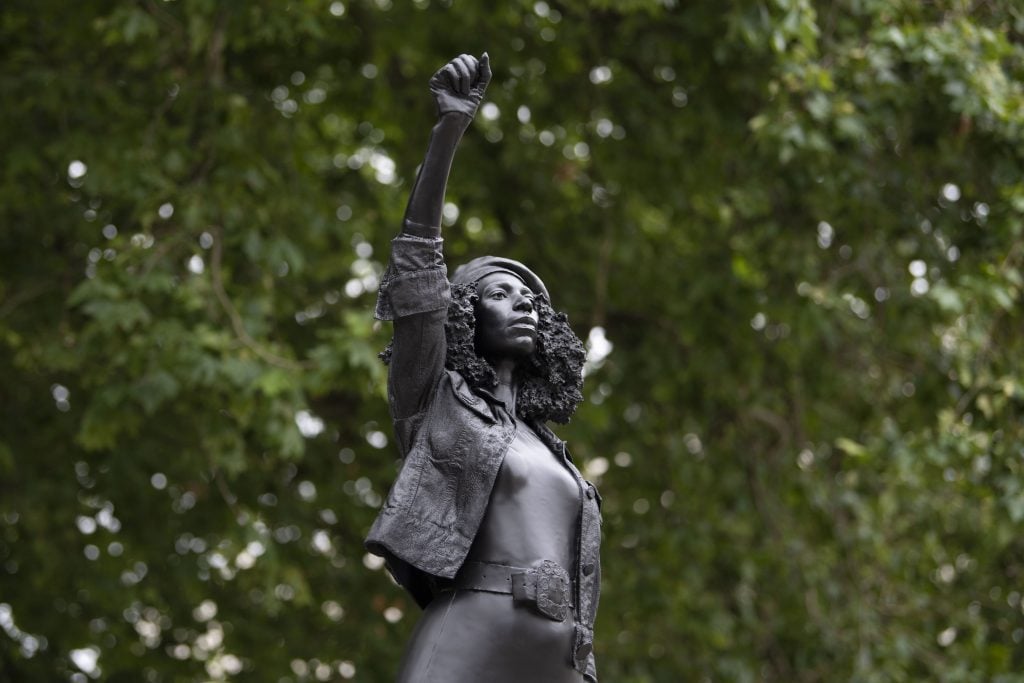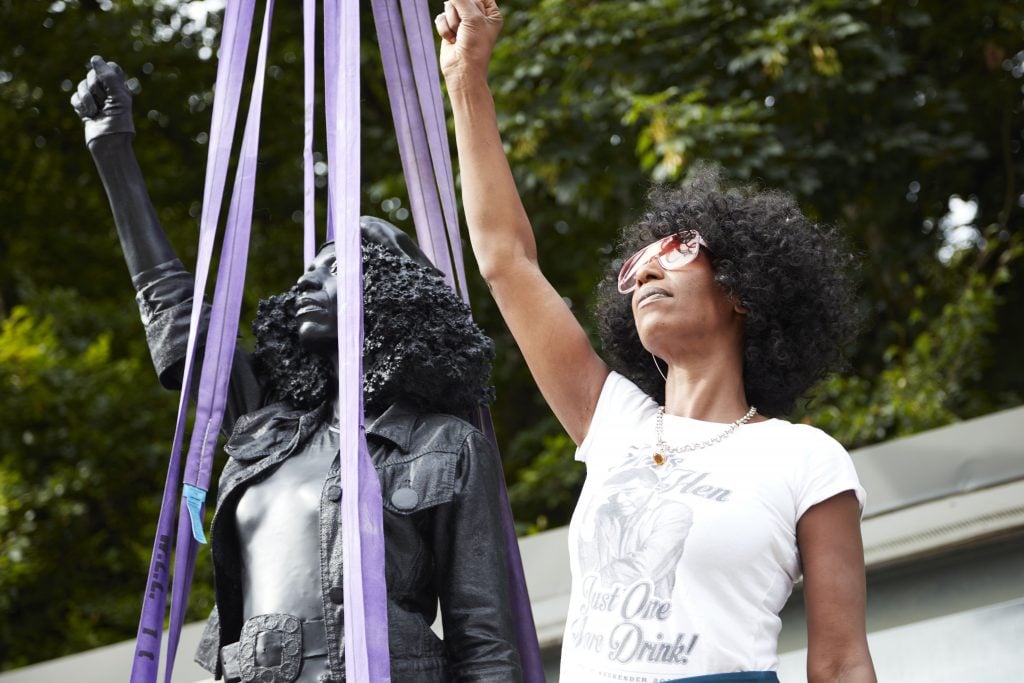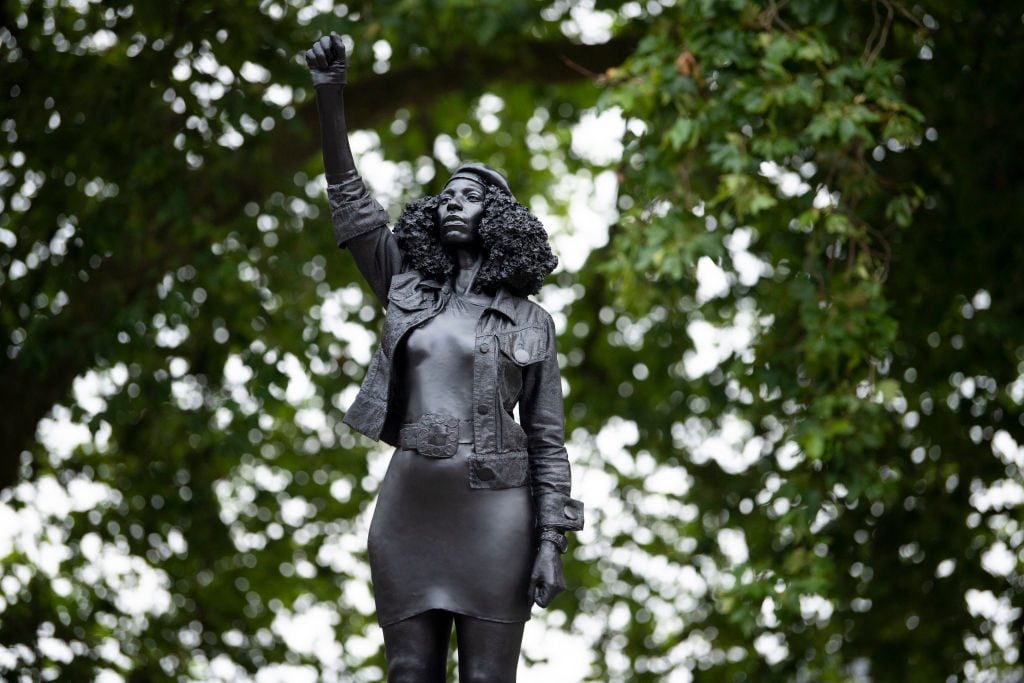Art World
After a Monument to a UK Slaver Was Toppled, Artist Marc Quinn Replaced It With a Striking—and Unauthorized—Statue of a Black Lives Matter Activist
The sculpture was installed without permission—and not everyone is happy about it.

The sculpture was installed without permission—and not everyone is happy about it.

Naomi Rea

The artist Marc Quinn has installed a sculpture of a Black Lives Matter activist in place of a torn-down monument to a 17th-century slave trader in Bristol.
Quinn unveiled the artwork in the early hours of Wednesday, July 15, after installing the sculpture without permission from local authorities. As a gesture toward the need to take direct anti-racist actions in the public space, the YBA artist’s move has been celebrated by some, but others are unhappy that the decision was made without consulting local residents.
The sculpture occupies a vacant plinth that once held a monument to Edward Colston, a prominent member of the Royal African Company who made his wealth off the back of its trade in enslaved people. The statue was theatrically torn down and dunked in Bristol harbor on June 7, at the height of the Black Lives Matter protests that erupted in response to the death of George Floyd in the US.
The new statue depicts the local activist Jen Reid, images of whom spread across the internet in the wake of the dramatic monument toppling after she climbed on top of the empty plinth and raised her fist making the Black Power salute.
In a statement, Reid explains that the action was spontaneous, driven by an “overwhelming impulse” on her way home from the protests. “It was like an electrical charge of power was running through me,” Reid says. “My immediate thoughts were for the enslaved people who died at the hands of Colston and to give them power. I wanted to give George Floyd power, I wanted to give power to Black people like me who have suffered injustices and inequality. A surge of power out to them all.”

Marc Quinn, A Surge of Power (Jen Reid) 2020 (2020). Jen Reid stands with the artwork before it is installed. ©Marc Quinn studio.
The sculpture is fittingly called A Surge of Power (Jen Reid) 2020, and Reid says she hopes it offers a sense of pride and belonging to Black people, who are seldom depicted and celebrated in public sculpture.
Quinn decided to make the sculpture after seeing the picture of Reid on Instagram. “It is such a powerful image, of a moment I felt had to be materialized, forever,” Quinn says in a statement. The artist’s work often engages with the news, such as his ongoing “History Paintings” series, which began after the police killing of Mark Duggan in the UK in 2011.
The sculpture was installed without formal permission from local authorities, a move that has not been welcomed by all. Many were hoping the vacant platform would be given over to a Black artist.
The artist Hew Locke, who has been making work about problematic monuments in the UK and the US for decades, is among them. “The people of Bristol were not consulted, it feels arrogant,” Locke tells Artnet News. “It is as much to do with the sculptor’s ego than it is about BLM. It’s like squatting. Surely the whole point about all the discussions on statues recently has been to do with the fact that the community must be involved. He’s done it because he has the money to do it.”

A new sculpture, by local artist Marc Quinn, of Black Lives Matter protestor Jen Reid stands on the plinth where the Edward Colston statue used to stand on July 15, 2020 in Bristol, England. Photo by Matthew Horwood/Getty Images.
“The sculpture that has been installed today was the work and decision of London based artist. It was not requested and permission was not given for it to be installed,” Bristol’s mayor, Marvin Rees, says in a statement. The council has established a history commission to consider how best to tell the city’s history and decide the future of the plinth. It is unclear whether the council plans to remove the sculpture.
Quinn does not expect the sculpture to be permanent, but explains that he felt that the time was ripe for direct action in the public realm to combat institutionalized and systemic racism. “Jen [Reid] and I are not putting this sculpture on the plinth as a permanent solution to what should be there,” he says, adding “it’s a spark which we hope will help to bring continued attention to this vital and pressing issue.”
If the sculpture is eventually sold, the profits will be donated to two charities chosen by Reid that focus on building Black British history into the national curriculum, Cargo Classroom and The Black Curriculum.
Quinn has made public art before, including a sculpture of the artist Alison Lapper when she was pregnant for Trafalgar Square’s Fourth Plinth in 2005, and he speaks of the public realm as a space to ignite discussion and create change. “The plinth of Edward Colston in Bristol seems the right place to share this sculpture about the fight against racism, which is undoubtedly the other virus facing society today,” Quinn says.